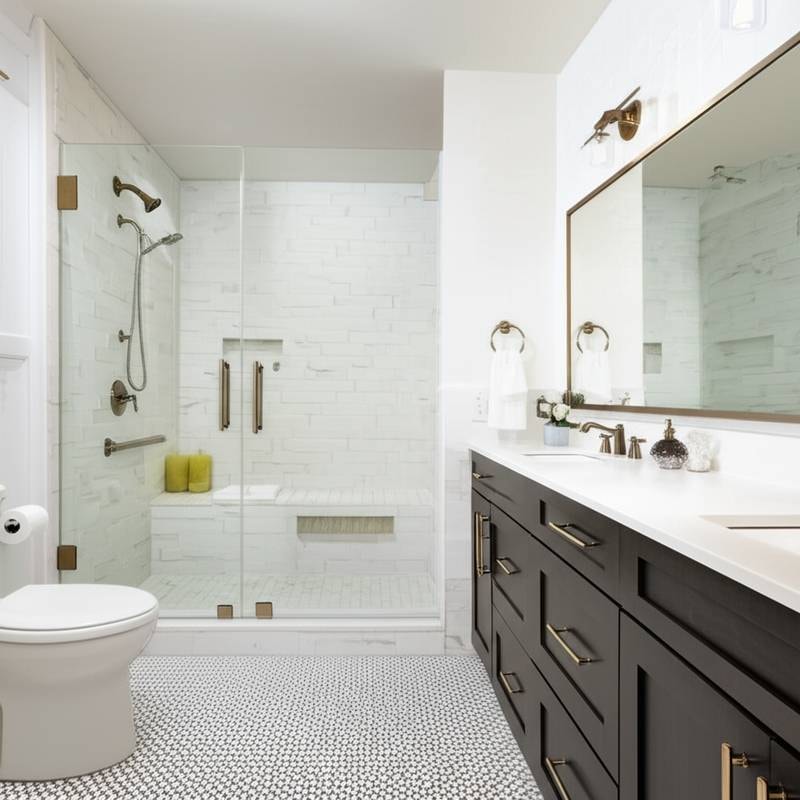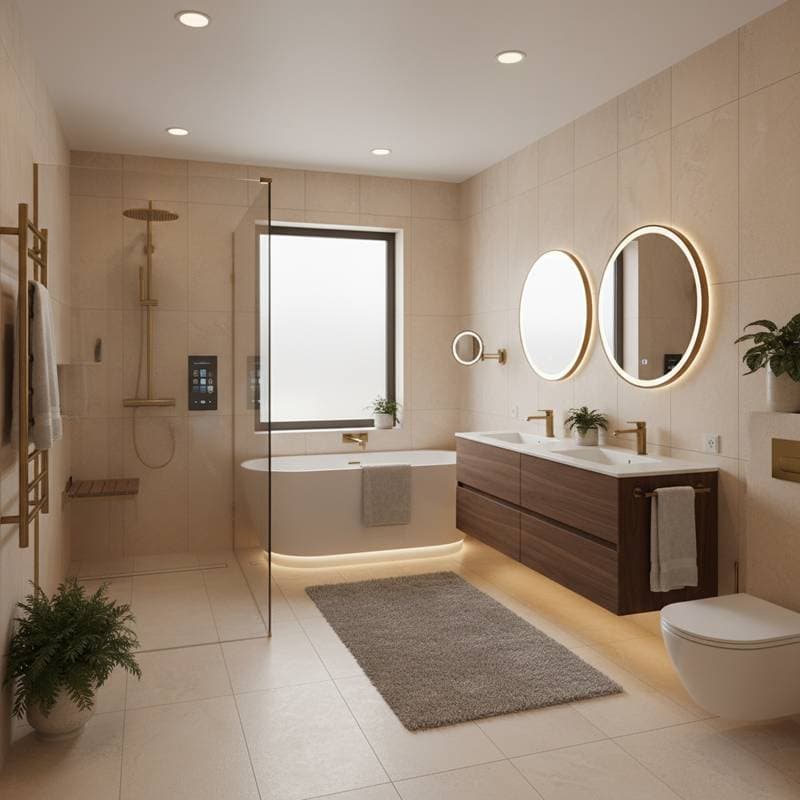Bathroom Upgrades for Aging in Place That Enhance Resale Value
Bathrooms serve as essential spaces for daily routines, relaxation, and personal care. As residences adapt to support occupants across life stages, aging-in-place principles have shifted from specialized options to core elements of effective design. An accessible bathroom improves safety and autonomy while contributing tangible worth to the home. The finest examples integrate purposeful features with elegant details, yielding environments that appear enduring rather than utilitarian.
This guide presents seven targeted bathroom improvements. Each option harmonizes accessibility with superior craftsmanship, demonstrating how inclusive elements enrich routine use and property investment.
1. Zero-Threshold Showers for Seamless Access
Walk-in showers eliminate curbs and steps, facilitating easy entry for individuals with reduced mobility. These designs deliver a streamlined floor plane that aligns with current architectural trends. Designer Sarah Linton of Linton Studio recommends large-format porcelain tiles in neutral shades, such as Fired Earth’s Clay 03, to ensure continuity between the main floor and shower area. Gentle slopes guide water to linear drains, preserving a refined appearance free from dated, stark aesthetics. Such configurations foster openness, grace, and simplicity in movement.
2. Integrated Grab Bars as Stylish Safety Elements
Contemporary grab bars extend beyond basic utility. Products from the Invisia Collection or Moen’s Designer Series blend into towel bars and shelves with finishes like brushed nickel, matte black, or polished brass. These selections match surrounding hardware, elevating safety aids to decorative highlights. Strategic installation includes vertical and horizontal placements near shower entries and toilets for comprehensive support. Proper positioning integrates these bars into the overall structure, avoiding any sense of retrofit.
3. Chair-Height Toilets with Optimized Layouts
Toilets elevated to chair height, measuring seventeen to nineteen inches from the floor, offer ergonomic benefits for users of varying abilities. Architect James Corbin of Corbin Residential Architecture combines these with thirty-six-inch clearance zones on the sides to accommodate wheelchairs or assisting caregivers. Features like soft-close lids, built-in night lights, and hidden cisterns add convenience and polish. This setup maintains user respect and fluidity without sacrificing visual appeal.
4. Textured Flooring for Secure and Elegant Surfaces
Flooring demands attention in bathrooms designed for long-term use. Options such as textured porcelain tiles, honed limestone, or engineered stone with subtle etching provide traction alongside sophistication. Interior designer Elena Rossi of Atelier Rossi favors Caesarstone Cloudburst Concrete for its dynamic patterns and smooth matte texture. She incorporates defined grout lines in contrasting colors to aid visual navigation for those with impaired depth perception. Together, these choices secure footing while cultivating a calm, upscale ambiance.
5. Layered Lighting Systems for Versatility and Safety
Multiple lighting layers fulfill practical and atmospheric needs. Dimmable LED strips under vanities, non-glaring sconces beside mirrors, and ceiling-mounted recessed lights form a cohesive illumination plan. Motion-activated sensors illuminate paths during low-light hours, enhancing security with minimal effort. Walls painted in Benjamin Moore’s Pale Oak amplify gentle light, particularly alongside brushed bronze accents. Lighting designer Clara Hsu of LightForm Studio advises warm white bulbs at 2700K for optimal warmth and visibility. The outcome yields a secure yet tranquil setting.
6. Functional Vanities with Ample Clearance
Floating vanities create space beneath for seated access and contribute to an open atmosphere. Materials like European oak or walnut veneer introduce organic warmth to predominantly hard environments. Quartz or solid-surface countertops withstand wear and simplify maintenance. Pull-out drawers with gentle mechanisms ease access, and rounded edges reduce potential hazards. Custom pieces from Harper & Co. Cabinetry feature integrated wooden handles for a fluid, modern profile.
7. Expanded Doorways for Effortless Navigation
Effective accessibility starts at the threshold. Doorways widened to thirty-two inches or more accommodate assistive devices and convey spaciousness. Pocket or barn doors conserve room while preserving unobstructed views. Lever-style handles replace knobs for simpler operation. Designer Mia Delgado of Delgado Interiors stresses the role of circulation in overall planning. Unobstructed routes connecting the vanity, shower, and toilet build user assurance and self-reliance.
The Lasting Benefits of Inclusive Bathroom Design
Superior aging-in-place bathrooms welcome all users through universal appeal. Selections in materials, hues, and hardware craft areas that uphold autonomy alongside refined style. Accessibility and aesthetics align as mutual objectives in these spaces. Intentional updates, including grab bars, broader entries, and versatile lighting, equip homes for tomorrow while enriching today.
Real estate experts acknowledge the advantages of proactive design. Prospective buyers value rooms that exhibit anticipation and superior execution. A forward-looking bathroom indicates a property with enduring care and innovation. This approach yields returns in monetary terms and personal satisfaction, providing reassurance now and attractiveness later.
Incorporating Personal Elements to Maximize Appeal
Personalization elevates any accessible bathroom. Consider a handcrafted ceramic vessel sink, aged brass wall lights, or a teak bench to add character. Humidity-tolerant plants like ferns or philodendrons temper rigid lines and introduce vitality. These accents convert a utilitarian area into a bespoke haven reflective of its inhabitants.
Prioritizing durability calls for selective, high-quality choices rooted in consideration. A bathroom that facilitates graceful aging and assured resale embodies intentional habitation.










